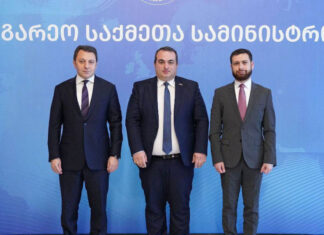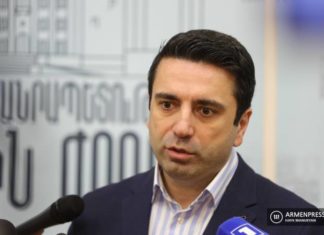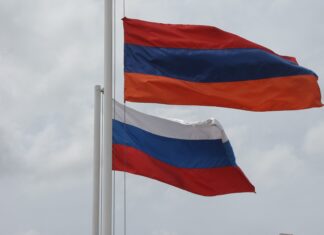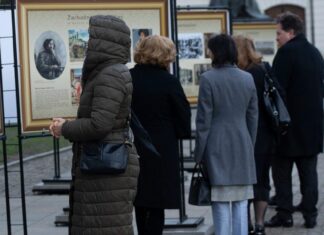YEREVAN/RIGA — My friend Naira Khachatryan, a specialist in Latvian, brought Latvian artist and dancer Karine Paronjanc (Paronjanca/Paroniants) to my home last September. Her name was familiar to me, and I had written about her in my book, Armenians in the World Dance. A warm friendship immediately began with beautiful Karine, and I was completely overwhelmed with the need to introduce her to the greater Armenian world.
Karine was born in Riga; she obtained her master’s degree while studying at the Department of Monumental Painting of the Latvian Academy of Arts. In 2007 she studied fresco and graffito techniques at the Florence Art Institute in Italy. She has had more than 20 solo exhibitions in Latvia. She regularly participates in group exhibitions in Latvia, as well as in international art projects. Since 2007 she has been a member of the Latvian Union of Artists.
Her current studio is located in one of the historical buildings of the Riga Botanical Garden. The neighborhood includes pavilions with exotic plants, scientific laboratories, buildings of an old manor house and the lecture hall of the University of Latvia.

Dear Karine, it was a great pleasure to meet you in Yerevan, though it was a tragic time for our people. What were your feelings in Yerevan?
Artsvi jan, the Armenian community of Latvia was very concerned about what is happening in Armenia. Being a public person, I have raised the issue of the blockade of Artsakh and the war in the media space very actively and repeatedly. Of course, I flew to Armenia with a heavy heart. Initially, the trip had been planned as a pilgrimage, including a visit to see the myrrh preparation in Echmiadzin. But in the end, the event was cancelled. I decided to come to Armenia in spite of the fact that many people discouraged me, many were afraid to fly into Armenia: it seemed the enemy would go further. I did not regret the decision; I was happy to see that the city lives in spite of the national calamity: the life was bubbling, including the cultural life, and there were many tourists. Well done, Armenians! Despite the difficult economic situation in the country, they have managed to accept about 100,000 refugees from Artsakh. Activists have been and continue to be active on the streets of the city and in social networks.
I always say that when I come to Yerevan, I hear the voices of Babylon. Armenians are carriers of ancient culture and it is felt in everything, even in everyday life. There are so many layers of the past there, it is such a birthday cake for antiquity lovers: legends, myths, history, East and West, Silk Road and Byzantium; such a mix of cultures, dialects. People’s genetic memory keeps the spirit of Great Armenia. The gene of David of Sasun, the gene of the winner is very strong in the inhabitants of this long-suffering country. We love holidays, we know how to receive guests, we know how to be generous and hospitable even now, when the businessmen, who fancy themselves hegemons, mercilessly redraw the map of the world, and the very statehood of Armenia is put under great question. There is a lot of strength in our culture. Of course, like all southerners, we are too fond of celebrating life, and like all representatives of ancient peoples, we rely too much on the achievements and victories of years gone by.










